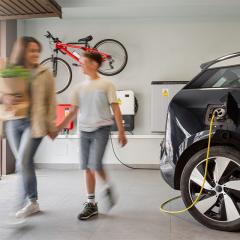 AIBE Explainer Series
AIBE Explainer Series
The AIBE Explainer series provides a breakdown of some of the key economic issues facing Australians today. This explainer has been written by our Director Professor Flavio Menezes, AIBE’s Westpac Fellow Dr Andrea La Nauze and HDR Scholar Thara Philip.
The pathway to net-zero emissions by 2050 is clear. It starts with the decarbonisation of the electricity sector. It then moves to the electrification of the transportation fleet. Finally, it requires thinking about difficult-to-abate sectors, including heavy industry, aviation, and materials.
In our last Explainer, we focused on green hydrogen and the role it may play as a fossil fuel substitute in the difficult-to-abate sectors. In this Explainer we turn to electric vehicles (EVs) and how they can assist to decarbonise our energy system.

What is an Electric Vehicle?
EVs are vehicles that are powered by electric motors instead of internal combustion engines. When charged using renewable energy sources like solar or wind power, EVs emit no greenhouse gases. Beyond their environmental benefits, EVs also offer potential advantages such as reduced air and noise pollution, improved energy security due to their ability to act as mobile batteries, and lower vehicle operating costs.
What are the different types of electric vehicles
There are four different types of EVs:
- Battery electric vehicles (BEVs): These are fully electric and use an external charging outlet to charge the battery.
- Plug-in hybrid electric vehicles (PHEVs): These can be charged with electricity using a plug but also contain an internal combustion engine that uses liquid fuel.
- Hybrid electric vehicles (HEV): These are powered by a combination of electricity and liquid fuel. Unlike PHEVs, they do not use an external plug to charge the vehicle. Electricity is produced only through regenerative braking, which converts kinetic energy during the process of slowing down a vehicle back into electricity.
- Fuel Cell Electric vehicles (FCEV): They use ‘fuel cell’ instead of, or in combination with, a battery- to generate the electricity required to run the vehicle. These are typically fuelled by hydrogen. The uptake of FCEVs is currently limited.
Table 1 below provides a summary of the different types of vehicles. The main feature to note is that when powered fully by renewable electricity, BEVs emit the least GHG emissions compared to all other technologies.
Table 1: Types of electric vehicles
| Battery Electric Vehicle | Plug-in Hybrid Electric Vehicle | Hybrid Electric Vehicle | Fuel Cell Electric Vehicle | |
|---|---|---|---|---|
| Acronym | BEV | PHEV | HEV | FCEV |
| Power train (the set of components that generate the power required to move the vehicle) | Electric | Electric + Combustion | Electric + Combustion | Electric + Electrochemical |
| Plug-in | Yes | Yes | No | No |
| Top-up | Electricity | Fuel and electricity | Fuel only | Hydrogen |
| Regenerative braking | Yes | Yes | Yes | Yes |
How do you charge an electric car?
An EV can be charged at your residence, workplace, or other public charging stations. There are nearly 5000 public chargers spread across 2,392 locations in Australia and the number is expected to grow in the coming years. The figure below displays the different methods that can be used to charge an EV.
Figure 1: Methods of charging an electric vehicle
| Level / Mode | Charge Type | Which EV's |
|---|---|---|
| Level 1 Mode 2 | AC trickle charge uses a standard 220 V regular plug. This adds between 10 and 20 km of range per hour and is the slowest method of charging your EV. It could take between 25 and 45 hours to fully charge your BEV. | PHEV BEV |
| ||
| Level 2 Mode 3 | AC fast charge uses a dedicated EV charger up to 22 kW. This adds between 40 to 100 km range per hour. Setting up a dedicated AC fast charger (also called a wall-box) typically costs $1000-$2000 + installation by an electrician. | PHEV BEV |
| ||
| Level 3 Mode 4 | DC fast and ultra-fast charge is the fastest way to charge. Power levels of these chargers vary from 25 kW to 150 kW (fast chargers) or up to 350 kW (ultra-fast chargers). Ultra-fast charging can add about 400 km range within 15 minutes but is currently only supported by a few BEVs in the market. | BEV |
| ||
The time taken to charge your EV depends on the battery capacity of your EV, the type of charger and other factors such as battery level remaining and temperature.
The higher the battery capacity (kWh) of the EV, the more electricity it can store and the longer it takes to fully charge. This means a Tesla Model Y with a 60 kWh battery would take longer than a Nissan LEAF with a 40 kWh battery to fully charge when connected to the same type of charger.
The lower the power output (kW) of the charger, the longer it takes to charge. For instance, an EV would take less time to fully charge when connected to a 22 kW AC fast charger as opposed to a 7 kW AC charger.
What is the cost of owning an Electric Vehicle?
The price of electric car models available in Australia varies from about $45,000 to $346,000. However, as of February 2023 waiting lists at many Australian dealers have no predicted delivery dates for EVs.
EVs are currently higher priced compared to their conventional counterparts. This can be attributed to high battery costs and low volume of production. With improving technology and increasing economies of scale, electric vehicles are expected to achieve purchase price parity with conventional vehicles in the mid-late 2020s in Australia.
When talking about the costs of owning a vehicle - electric or not - operational and maintenance costs are also important.
How much does it cost to charge an electric car?
The total cost of charging your EV can be estimated by multiplying energy consumed (kWh) and tariff rate. A tariff is a price you are charged for the energy used. Electricity rates could be different in different regions and may vary depending on where and when you charge. The table below shows the costs of charging an EV for different charge locations:
Table 2: Cost to charge an electric vehicle
| Location of charging | Home | AC public fast chargers | DC public fast chargers |
|---|---|---|---|
| Factors determining charging costs | Electricity tariff rates, location, time of day | Location, type of provider | Location, provider, type of charging (fast vs ultra-fast), time of day |
| Costs | About 8 to 35 cents per kWh | These are found at shopping centres, hotels, and some workplaces, and are usually free for guests to use. However, parking fees or time limits may apply at some locations. | About 40c/kWh for fast chargers, and 60c/kWh for ultra-fast chargers. Some EV users have access to free fast charging. For example, some Telsa users have free access to Tesla supercharging network. |
How does the cost of charging an EV compare to the cost of fuelling a conventional vehicle?
To understand this better, we compare one of the cheapest EVs available in Australia – the MG ZS EV - and its fuel-powered equivalent MG ZST. MG ZST has a fuel economy of 7.1 L per 100 km whereas MG ZS EV is rated at 17.1 kWh/ 100 km.
Let’s consider an average Australian based in Brisbane who drives about 35 kilometres per day.
As of April 2023, the cost of regular unleaded fuel is 201 cents per litre. For the purpose of estimating charging costs, two prevalent rates provided by Origin Energy’s residential electricity plan are used: A flat rate of 25.82 cents/ kWh, and time-of-use off-peak of 20.32 cents/kWh.
Figure 2: Comparison of costs of charging an EV vs fuelling an equivalent conventional vehicle
| Vehicle and mode of refill | Running cost/year | Saving of EV charging compared to fuelling ICEV |
|---|---|---|
| MG ZST (Regular unleaded) | $1768 | Not applicable |
| MG ZS EV (Flat-rate tariff) | $421 | $1347 |
| MG ZS EV (Time-of-Use tariff) | $547 | $1221 |
| MG ZS EV (Fast charging) | $843 | $925 |
An EV owner who relies solely on electricity generated from their rooftop solar wouldn’t be spending any money to power their vehicles, but instead will receive less revenue from exporting their excess solar to the grid. EVs also have 40% lower maintenance costs than equivalent internal combustion engine vehicles.
We have explained what is an EV, how it is charged, and how much it costs to own an EV. In the second part of this AIBE Explainer, we will explore how the charging behaviour of EV owners will be crucial to achieving net zero emissions by 2050, a topic that is also the subject of ongoing AIBE research.
Fair, promising and feasible futures
At the Australian Institute for Business and Economics, we work with partners in business and government toward fair, promising and feasible futures. Learn more about us.
If you have any suggestions for future explainers, contact us at aibe@uq.edu.au.






